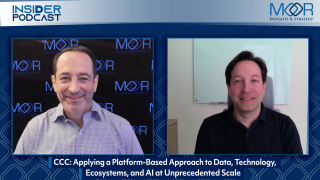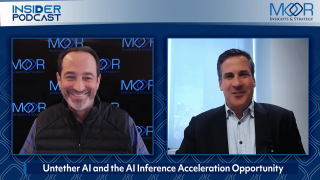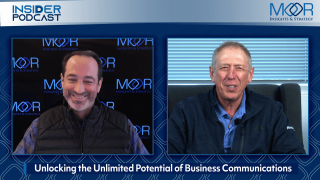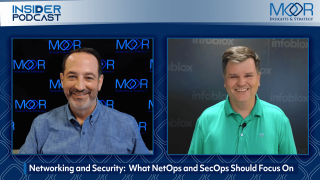On this episode of the Moor Insights & Strategy Market Spotlight, host Will Townsend discusses Juniper Networks Beyond Labs initiative with CTO Raj Yavatkar, unpacking investigations tied to networking and AI, sustainability, 5G and quantum secure communications.
This is a great conversation you don’t want to miss!
Watch the full video here:
Listen to the episode here:
TRANSCRIPT
Will Townsend: Hi, I am Will Townsend, the vice president and principal analyst for networking and security at Moor Insights & Strategy. Joining me today for a Moor Insights & Strategy market spotlight conversation is Raj Yavatkar. Hope I pronounce that right, Raj. You’re the CTO of Juniper Networks. It’s great to see you.
Raj Yavatkar: Same here. Thank you.
Will Townsend: Well, let’s talk about Beyond Labs. And so, you launched this initiative in May. I was pre-briefed on it. There are a lot of infrastructure companies and even service providers that do proof of concept labs, but I was really struck by your approach. It’s very unique, focusing on pioneering research, pathfinding projects, and experimental technology developments. And so, recently, you’ve narrowed that focus into four key categories. So, it’s been about six months since you’ve launched Beyond Labs, Raj, and I’m wondering how’s it going?
Raj Yavatkar: I think it’s going great. I think customer feedback, especially as we expose customers to our partnerships, our approach to looking at pathfinding and innovation through our EBCs and other presentations has been very positive. And we’ve also been able to focus on certain areas, like you said, artificial intelligence and machine learning, sustainability, quantum security technologies like liquid cooling and so on. So, all of those pieces are now beginning to come together, which is really happy to see that.
Will Townsend: Well, let’s jump into it. And so, there’s a lot of excitement around AI, with generative AI. I mean everyone is talking about it. There’s a whitewashing going on there. But it is exciting because it’s going to open up new opportunities. And certainly AI is nothing new. It’s been around for quite some time. But I’d love to get your take on the lab’s focus on AI.
Raj Yavatkar: Yeah, so for us at Juniper, AI is not new. About four years back for the wifi networks, we are the first in the industry to introduce what is known as cloud managed AI ops solution, where you apply artificial intelligence and machine learning for day zero, day one, day two operations of the network in a way that we define what we call service level expectations for our users or endpoints. And we measure the network behavior constantly by collecting telemetry and match it against the expectations to find any issues and proactively resolve them. And we have some customers like Fortune 1 company, largest courier in the world, also publicly stating that the 90% of their troubleshooting tickets get self resolved by AI. Now, we are expanding that concept to the restaurant network by what we call end-to-end assurance, go from Wi-Fi campus brand switching [inaudible 00:02:52] access data center network, even core network apply the same principles for applying artificial intelligence based ops to automate the network operations. So, that’s going really well. Right.
Will Townsend: That’s great. And you mentioned assurance. And that’s where really AI has shined when you talk about AI ops and that thing. And for our viewers that are not familiar with the concept of AI ops, it’s infusing artificial intelligence into the network to improve visibility, to interpret telemetry and that sort of thing. But Raj, I’m curious, so specifically to networking, where do you see the applications for generative AI? Because I think there isn’t a lot of discussion when you double click into networking, from my perspective at least.
Raj Yavatkar: So, there are two main areas where I see generative AI being applied, and we are beginning to do that. One is the product stem cells. So, if you look at the networks today, they are operated by network engineers using CLI, command line interface, or some kind of a HUI. And that’s a very primitive way to interact with networks. So, for example, if you are working with an network, you may have 150 page document to consume to understand how to configure and operate such a network. But if you can train the large language model using these documents, it starts giving you answers. So, for example, we call it OS Junos. Junos is our operating system. OS Juno is a plugin to ChatGPT, which will allow you to ask any questions in a plain English or the language such as, well, I want to configure EVPN on this switch or this part of the network. And it automatically generates the necessary scripts, necessary commands, executes them.
So, that’s number one. How do we make the products more usable, more customer friendly using generative AI? Secondly, customer support. If you look at the customer support today is structured by L1, L2, L3. L1 support is really the people who understand the network documents a little bit at a shallow level. They’re able to answer customer’s questions, ask them to reboot the device or something like that. But now imagine that using generative AI, if you can take all the product documentation customer facing as well as logs, and use that to train the large language model, it can start providing automated element support. That’s a pretty powerful idea. So, we are pursuing that.
Will Townsend: I love the latter use case because that’s going to drive a better customer experience. It’s going to resolve issues much more quickly, and I think it’s going to be very, very compelling. And then just taking generative AI and simplifying the complexity, that’s typically involved with managing networks. I mean networks are becoming very complex. And you have enterprise wifi networks, you have wired networks. You now have private wireless networks. And all of this complexity creates overlays. And so, to provide a generative AI interface. You don’t have to train network operators to the Nth degree and you’re able to enable I think just a smoother facilitation of network management. And there’s this trend towards lighter IT, especially in smaller and mid-market size companies, but even some of the larger enterprises are going light IT. Correct?
Raj Yavatkar: That’s right. I think absolutely. I think there’s a huge opportunity to change the way people think of network operations. We are already applying it by ops, but generative AI takes us to the next level. Yeah.
Will Townsend: Yeah, it’s super exciting and I think there’s more to come. I think with any new technology or again, AI is not new, but the notion of generative AI is relatively nascent and new. There are use cases that I think we’re not even thinking about right now. And I think initiatives like Beyond Labs is going to help birth those new use cases. So, it’s very exciting. But with that, let’s move to sustainability. And this is another hot topic. I mean every company has a net zero goal by 10 or 15 years from now, and it’s just good to reduce carbon emissions because that’s a huge challenge globally. And it’s certainly in places like Europe that, I don’t want to call it an energy crisis, but certainly with the current geopolitical environment and the fact that Russian oil is not flowing anywhere basically around the world, they’re really having to struggle with conserving energy. And so, again, sustainability is really huge green. It’s really huge. And I’m just wondering how is Juniper approaching the sustainability challenge? And what can we see, I mean from the networking perspective, but just even more broadly speaking?
Raj Yavatkar: So, for us in Juniper Beyond Labs, sustainability is one of the most important initiative because we want to be good corporate citizens. Climate action is real. We are trying to address that. But to your point, sustainability is more than energy efficiency. It has to be applied to all the aspects of a product development delivery that we do. So, what we are trying to do now is that we are looking at our supply chain and see how we can improve the energy efficiency in the supply chain with respect to how the products are manufactured, assembled, packaged. We can change the packaging to be more sustainable. We can look at the packaging to see what parts of packaging are not necessary, for example. That same thing we can take to the next level with respect to energy efficiency of network operations.
If you look at the networks being operated, utilization of the network varies tremendously during the day and time in the night also. So, if you can collect the time series data on network utilization in a core of the network where we have large chassis based routers, which are lots of line cards, redundancy built in, inside fabric, which connects these line cards. Now using the time series data and artificial intelligence, we can predict what the throughput is going to be, what the utilization is going to be. And we can turn off parts of the switch, parts of the router, parts of the line cuts, parts of the fabric, and that can save lots of energy. The other is cooling. We are partnering with external companies which are innovating in the area of liquid cooling or immersion cooling, and applying that to see how can we make the products more sustainable, more energy efficient.
Will Townsend: There’s a lot of talk around observability these days. Network observability, data observability. And having deeper granular levels in T network performance like you’re describing, can allow you to do a lot of the things that you’re doing as well. I think we’re beginning to see a lot of the fruits that are coming out of this research. And even this week, spending time virtually with AWS re:Invent. And they open one of their sessions talking about observability. So, I think that is really key, at least from my perspective, in achieving sustainability. But I want to move to the third focus for the lab, and this is something that I love to talk about, 5G. I do a weekly podcast, the G2 on 5G, we should actually have you on one of these days, Raj. But I’d like to talk about that. Certainly Juniper has been a leader with respect to RAN intelligent controller. But I’m wondering, what other investigations is the Beyond Labs team focused on that’s really going to drive the innovation beyond just the speeds and feeds of low latency and fast throughput?
Raj Yavatkar: So, the Beyond Labs really is trying to make sure that if you look at the O-RAN as a industry initiative, it’s a strategic inflection point. It’s going to take some time and effort to make it happen because the traditional vendors are not going to support that desegregating the entire network. So, Beyond Labs, what we are doing is we are developing partnerships to develop a strong ecosystem of people or companies that provide different parts such as xApps, rApps, which can optimize the network independent of who’s providing the radios. So, RIC is a platform acts like our operating system. On top of that, you can build applications now using machine learning for optimizing spectrum, optimizing energy efficiency, or even optimizing the network operations across multiple cell sites. So, that’s something that we are taking very seriously and have already developed a partner ecosystem with partners like Ira Technologies, [inaudible 00:11:28] Technologies, Rimedo Labs, which are developing third party applications, which will run on top of our RIC to do the optimization of the network.
Will Townsend: And traditionally, Juniper has been very strong in the service provider community. Although I will give you lots of credit with your missed acquisition. You’ve been really building your capabilities within enterprise. But I know from a service provider perspective, from a mobile network operator standpoint, you’re working with companies like Rakuten and Vodafone. And I know that I’m a GLOMO judge again this year for Mobile World Congress, Barcelona. And I know, I believe it was Vodafone that won an award. And I believe they were leveraging some of your capabilities, right?
Raj Yavatkar: Yeah. So, one of the things we’re very happy to receive the GLOMO Award. It’s an industry recognition to be the top provider, but what we are beginning to see that we are now going from field trials to actual commercial deployment of the RIC. So, for example, we are ending this year with some revenue coming from service providers in terms of how we are deploying the RIC. So, next year is going to be very important to scale those deployments into commercial environments. Our goal is, an industry’s goal is if you talk to Vodafone or other telcos, they’ll tell you they expect the 20% of the 5G network to be O-RAN based at some point like 25%, 26%. So, we have to work towards that and that’s what we are working towards with respect to. And Beyond Labs playing an important role because we host the RIC platform and its ecosystem. So, making this strategic inflection point happen in the industry is a big challenge as well as opportunity.
Will Townsend: And I think one of the challenges I think with Open RAN has just been codifying the standards and there are a lot of organizations that are involved. I mean I applaud the work that you’re doing with Beyond Labs. But you have a RAN Alliance, Open RAN policy coalition, you’ve had TIP trying to harmonize a lot of that, and then you’ve had companies like Rakuten with Symphony and Symworld. And recently NTT with OREX trying to simplify that entire process. So, again, I applaud your effort. It’s not a hockey stick adoption from my perspective. I think we’ll see deployments in greenfield networks such as Reliance in India, Rakuten in…
Raj Yavatkar: Japan.
Will Townsend: … In Japan, and then Dish. Hopefully Dish can move forward in the US with their initiatives as well. But earlier I touched really briefly on private wireless. And this is a huge opportunity from my perspective, especially in operational technology environments where densifying with Wi-Fi and especially in outdoor environments and that thing just doesn’t work. And typically in manufacturing environments there’s a lot of metal that creates Faraday cages. And so, I’m wondering, what are you seeing with private wireless? Because I think we’ve seen good solid adoption with LTE, but 5G adoption has been somewhat slow to take off.
Raj Yavatkar: That’s right. So, for us it’s not either or. It’s not wifi or 5G. We look at this as a very integrated converged private mobile network. So, we are partnering with Solana Networks, for example, to combine our missed wifi solution with their private 5G, so we can provide enterprise solution. But we really believe in our vision of boundless private mobile networks, irrespective of whether you’re running Wi-Fi or 5G, or both, and do really seamless handoffs and so on. And we are working towards that with respect to developing in Beyond Labs itself, a new stack which will allow us to do this kind of a boundless private 5G network. So, that’s something I’m really excited about. And you’ll start seeing some demos and actual proof of concepts.
Will Townsend: I love that approach because typically what occurs when you start layering these different networks then is you get overlays. And I mentioned earlier the complexity with network overlays and that sort of thing. And it’s just, it’s untenable. And I think the other challenge, cellular has traditionally been a redundancy within the enterprise. It’s not been a primary modality. I’m very familiar with Solana and what they’re doing. I think they’re doing a total solution in a box. So, core ran, transport, it’s very clean. And so, it sounds like you’re doing some promising things with them to simplify just bringing that all together.
Because Raj, I totally agree with you. 5G is not going to kill Wi-Fi. I always like to say that 5G and wifi are better together or LTE, 5G and, wifi are all better together. But that’s great. Let’s move to our fourth topic, and I want to talk about something that might be a little esoteric to a lot of people and it’s quantum secure communications. And I know enough to be dangerous, Raj, I know about qubits and all of that, but it’s something that’s been around for quite some time, but it’s really quantum computing and quantum networking is really beginning to gain some steam.
In fact, at my firm, Moor Insights & Strategy, we do have an analyst that’s focused on quantum and I learn something new every time I talk to him. But I’d love to hear from your perspective. I mean, because I think there’s so much to focus on with quantum communications. And I like the fact that you’re focused on secure communications. But would love to hear what Beyond Labs is doing in that regard.
Raj Yavatkar: So, I think when you talk about quantum computing, you’ll notice that people always say next five years. That has been going on for some time. People keep on moving the ball downfield. But really if you look at the quantum computers and its application to quantum networking, this year we actually saw a development of technology, which is practical. So, we have taken the first step with respect to quantum key distribution. Now, as you know, quantum computing is going to change how cryptography works because we are going to have some call post quantum cryptography because we need completely new coding algorithms, which cannot be broken by quantum computers. But quantum key distribution solves a first fundamental problem, which is that how do we prevent man in the middle attack for key distribution? Especially symmetric key cryptography, but even for asymmetric keys. So, what we have done is working with a company called RKit. And we are also partnering with other companies in Juniper Beyond Labs.
We developed for our IPSec product, virtual symmetric key distribution using quantum entanglement. And now that part is actually deployed in four or five customers. So, it’s no longer science fiction, it’s actually here. And that is the first step towards quantum secure communication. We are also very active in ITF and HC, and other organizations to standardize post quantum cryptography and key distribution so that we can move into that world very quickly. But I’m very happy to say that using quantum the Beyond Labs work in a quantum key distribution, we have been able to show now that you can do quantum entanglement for key distribution. So, in a way, we are making the network more spooky to quote Albert Einstein who said quantum entanglement is a spooky action in distance. Now the network is becoming spooky after all.
Will Townsend: I love it. I love it. I wish it was Halloween because it would fit very well with the theme there.
Raj Yavatkar: That’s right.
Will Townsend: I’m wondering, how does Silicon come into the picture here? If we could go a little bit off script. I’ve spent time with Intel. They’re doing a lot of own confidential computing. There’s root of trust, there’s Secure Enclave. So, there’s a lot of capability in Silicon these days. So, I’m wondering how do you see that playing into what you just spoke about?
Raj Yavatkar: It’s a very good question. So, I was just at the Intel channel advisory board where I serve from Juniper point of view where they presented their roadmap, it speak to all the things they’re doing for confidential computing, including a trusted execution environment, Secure Enclave. Just as a matter of anecdote, I was one of the architects who worked on Secure Enclave 15 years back. It has taken Intel 10 to 15 years back to get the technology outside. So, I think the whole concept of confidential computing and what they’re providing is going to be very important even for a networking company like Juniper, because we use X statistics processor for control plane management, and all our applications run in that. So, I think now that the Silicon is providing not just the root of trust, but also providing this mechanism by which we can separate out things, has huge implications for cybersecurity, preventing ransomware, and so on. So, I’m really excited about that. I think we are going to see that applied to networking also.
Will Townsend: Well, it’s impressive that you were part of that whole initiative, Raj, with Secure Enclave. I guess that was a great question to ask. But it’s been a great conversation. I continue to be impressed with what Beyond Labs is doing. I think it’s going to drive innovation across the industry. I love the fact that you’re working with an ecosystem of partners as well, because you can’t do it all on your own. I mean, it takes a village really to build something compelling and earth moving. But hey, Raj, I want to thank you again for a very insightful conversation.
Raj Yavatkar: No, thank you. Thanks for the opportunity and look forward to talking to you again.





















































































